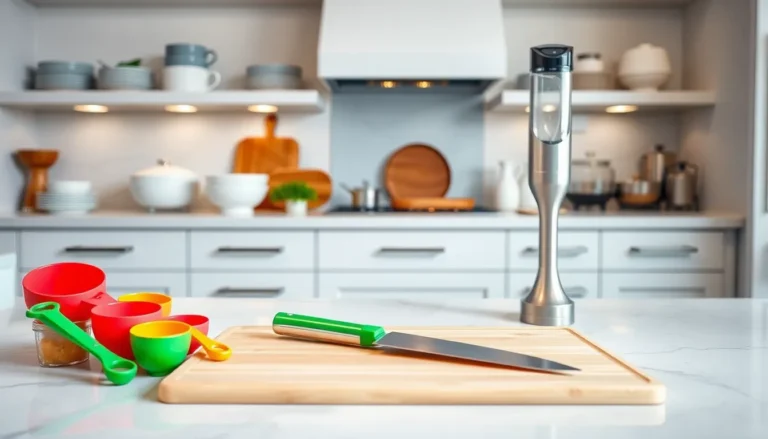In a world where gadgets seem to have a mind of their own, why not take matters into your own hands? DIY electronics projects offer a thrilling escape from the mundane, turning everyday materials into tech wonders that even your smartphone will envy. Whether it’s building a quirky robot or creating a custom LED lamp that makes your room look like a sci-fi movie set, the possibilities are endless.
Table of Contents
ToggleWhat Are DIY Electronics Projects?
DIY electronics projects encompass a broad range of activities where individuals create electronic devices using readily available components. These projects involve assembling circuits, programming microcontrollers, or integrating sensors, which encourage hands-on learning. Individuals can use items such as Arduino boards, Raspberry Pi units, and assorted electronic components, offering a vast landscape for creativity.
Hobbyists often engage in multiple types of projects, including building gadgets, developing robots, or creating smart home devices. Through these activities, he or she can gain practical skills such as circuit design and coding. Participants may also tap into a variety of online resources for guidance, such as tutorials and forums.
Types of DIY electronics projects span simple to complex builds. Beginners often start with basic LED circuits, while advanced enthusiasts may design intricate home automation systems. The flexibility of these projects allows for experimentation with different technologies, such as wireless communication modules or real-time clock circuits.
Collaboration frequently occurs within the DIY electronics community. Makers often share their experiences and innovations on social media platforms and dedicated websites. This sharing fosters a collaborative spirit, enabling individuals to learn from each other and improve their crafting skills.
DIY electronics projects provide a unique opportunity for creativity and technical growth. Individual engagement with these projects can lead to fulfilling experiences and the development of valuable expertise.
Benefits of DIY Electronics Projects

Engaging in DIY electronics projects offers numerous advantages. These projects encourage hands-on experience, fostering creativity and innovation.
Skill Development
Participants enhance technical skills through practical applications. Circuit design provides insights into electronic principles. Coding knowledge expands as makers write programs for their projects. Problem-solving abilities improve when troubleshooting issues arises. Many find that working with tools and components builds confidence and proficiency. As enthusiasts progress, they learn to integrate various technologies, further deepening their understanding. Collaboration with others in the community facilitates skill sharing and learning opportunities.
Cost-Effectiveness
DIY electronics projects often require minimal investment. Many commonly available components, like Arduino boards, are budget-friendly. Personal projects can save significant amounts compared to purchasing ready-made devices. Individuals can repurpose old electronics, thus reducing waste and minimizing costs. Many online resources provide free tutorials and guides, making learning accessible. By creating custom solutions, makers tailor projects to their specific needs without overspending. Over time, the skills gained in DIY projects can lead to money-saving opportunities in repairs and upgrades.
Popular Types of DIY Electronics Projects
DIY electronics projects attract makers of all skill levels. Various types cater to beginners, intermediates, and advanced enthusiasts, promoting creativity and technical growth.
Beginner-Friendly Projects
Simple LED circuits serve as one popular starting point. Individuals can create basic light displays using minimal components like resistors and LEDs. Another accessible project involves building a basic audio amplifier, which enhances sound output from mobile devices and offers hands-on experience with audio components. Furthermore, DIY electronic quizzes and games encourage learning through fun interaction. Completing these beginner projects boosts confidence and paves the way for more complex endeavors.
Intermediate Projects
For those with some experience, robotics projects provide an exciting avenue for exploration. Building a line-following robot combines fundamental programming with circuit design. Additionally, creating a weather station using Arduino allows for experimentation with sensors and data logging. Another noteworthy project involves integrating smart home devices, such as automated lights or temperature sensors. Intermediate projects enhance understanding and broaden knowledge in programming, electronics, and integrating multiple components.
Advanced Projects
Advanced makers can delve into intricate home automation systems. Developing a smart mirror that displays information combines hardware and software skills. Designing a custom drone expands technical challenges with flight control and programming for functionality. Another impressive advanced project includes creating a personal weather balloon equipped with sensors and cameras for atmospheric data collection. Tackling these challenges fosters deep expertise in advanced electronics, programming languages, and complex system integration.
Essential Tools and Materials
As DIY electronics projects vary in complexity, having the right tools and materials proves critical for successful outcomes. Basic tools include a soldering iron, which enables secure connections between components. A multimeter helps troubleshoot circuits, measuring voltage, current, and resistance effectively.
Wire cutters and strippers streamline the preparation of wires, ensuring clean connections. For precise placement, a breadboard serves as a reusable platform for testing circuits without soldering. Arduino boards and Raspberry Pi units act as versatile microcontrollers, facilitating numerous project ideas.
Essential supplies often consist of resistors, capacitors, and transistors. These components build functional circuits, creating the desired electronic behavior. LEDs provide visual feedback and can be used in various applications, from simple indicators to elaborate displays. Jumper wires make it easy to connect different components on a breadboard or circuit.
Safety gear should not be overlooked. Goggles protect the eyes during soldering, while an anti-static wrist strap prevents damage to sensitive components. A good workspace, equipped with adequate lighting and organization, promotes an efficient working environment.
For more advanced projects, consider additional tools such as 3D printers. These can create custom cases or components, further enhancing functionality. Software tools, including circuit design applications, assist in planning complex designs before assembly.
Through understanding these essential tools and materials, makers enhance their DIY electronics journeys, empowering them to create engaging projects. Each component plays a significant role in developing skills, from beginners to advanced enthusiasts, thus unlocking the potential for innovation.
Tips for Successful DIY Electronics Projects
Planning projects carefully increases the chances of success. Start by defining specific goals to understand the desired outcome. Research similar projects online to gather ideas and guidelines that streamline the process.
Gather all necessary materials and tools before beginning. Having components like Arduino boards, soldering irons, and multimeters ready makes the execution smoother. Organize the workspace to minimize distractions and enhance focus on the tasks at hand.
Experimentation plays a crucial role in innovation. Testing different configurations helps identify what works best for each project. Adjust components like resistors and capacitors to optimize circuit performance and explore new functionalities.
Documenting progress keeps track of ideas and modifications. Create a project journal to record steps taken, challenges faced, and solutions implemented. This practice aids in troubleshooting future endeavors and provides a reference for similar projects.
Safety shouldn’t be overlooked during DIY electronics projects. Wearing goggles and using anti-static wrist straps protects against common hazards. Understanding electrical principles empowers makers to handle components safely and responsibly.
Seeking feedback from the DIY community enhances learning. Sharing completed projects on social media can generate constructive criticism and new insights. Engage with forums to connect with experienced makers who can offer valuable advice and inspiration.
Lastly, staying patient is essential. Complex projects may require time and multiple attempts to perfect. Embrace mistakes as valuable learning experiences that pave the way for future successes.
Embracing DIY electronics projects opens up a world of creativity and innovation. Whether someone is a beginner or an advanced maker there’s always something new to learn and explore. The joy of transforming simple components into functional devices not only enhances technical skills but also fosters a sense of accomplishment.
By engaging with the vibrant DIY community individuals can share ideas and gain inspiration from others. This collaborative spirit drives continuous improvement and encourages experimentation. With accessible resources and budget-friendly components anyone can embark on their own electronics journey.
Ultimately the experience gained from these projects enriches both personal and technical growth paving the way for future innovations.



